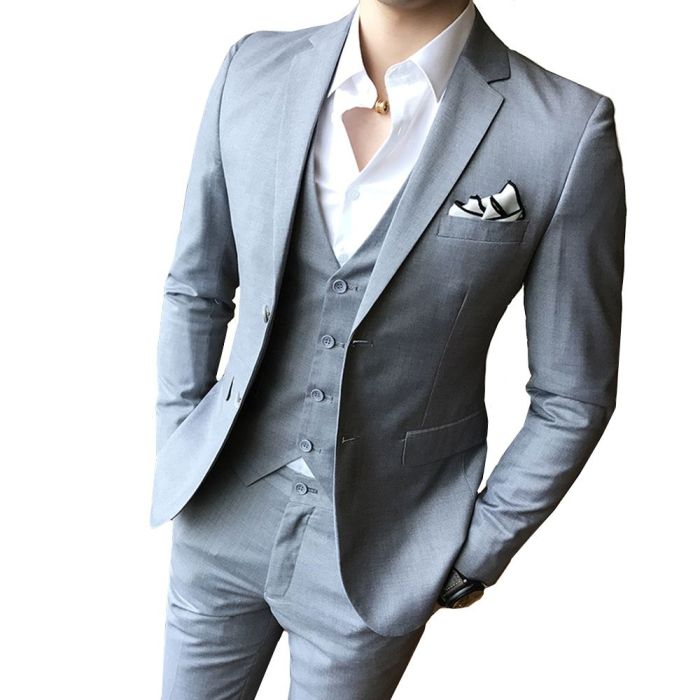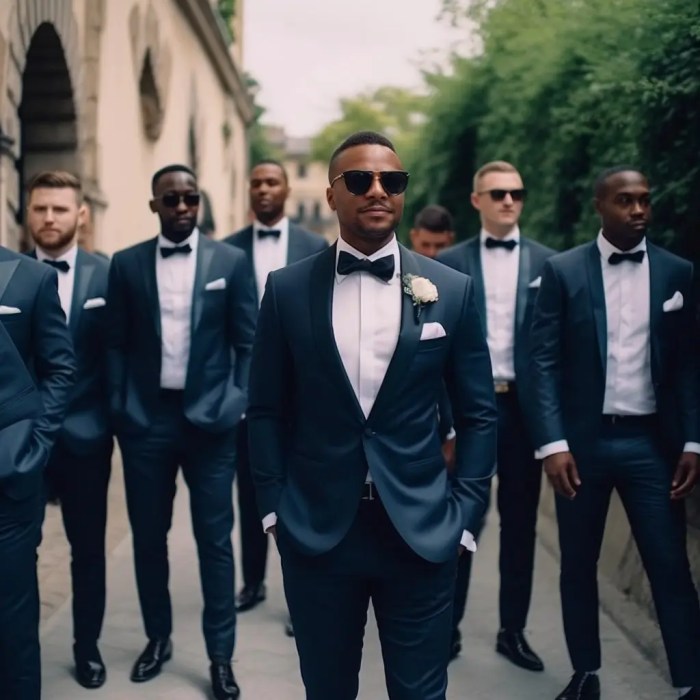Wedding Suit Styles
Wedding suits and dresses – Men’s wedding attire has undergone a significant transformation over the past century, reflecting evolving fashion trends and societal norms. From the formal, structured suits of the early 1900s to the more relaxed and personalized styles of today, the options available offer a wide range of choices for the modern groom.
Evolution of Men’s Wedding Suit Styles
The early 20th century saw the dominance of the classic double-breasted suit, often in dark colors like navy or charcoal. Mid-century styles leaned towards single-breasted suits with slimmer fits, influenced by Hollywood glamour. The latter half of the century introduced bolder colors and patterns, while the late 20th and early 21st centuries embraced a more diverse range of styles, from vintage-inspired looks to contemporary, tailored fits.
Today, grooms have the freedom to express their personal style through various cuts, colors, and fabrics.
Classic, Modern, and Contemporary Wedding Suit Styles
Each style offers a unique aesthetic, catering to different preferences and wedding themes. Classic suits maintain a timeless elegance, modern suits emphasize clean lines and a streamlined silhouette, while contemporary styles incorporate innovative design elements and unexpected details.
| Style | Lapels | Fit | Fabric |
|---|---|---|---|
| Classic | Peaked or notched, wider | Relaxed or structured | Wool, tweed, worsted |
| Modern | Notched, narrower | Slim or tailored | Super 100s wool, linen blends |
| Contemporary | Notched, peak, or shawl; varying widths | Slim, tailored, or athletic | Velvet, textured wool, patterned fabrics |
Appropriate Suit Styles for Different Wedding Venues
The formality of the wedding venue significantly influences the appropriate suit style. Formal settings like churches or ballrooms often call for classic or modern suits in dark, solid colors. Informal venues, such as rustic barns or outdoor gardens, allow for more relaxed styles and bolder color choices. Beach weddings might necessitate lighter fabrics like linen or seersucker in pastel shades.
Selecting the perfect wedding attire involves careful consideration of both suits and dresses. For the bride, a dazzling option might be a breathtaking gown, perhaps even one incorporating shimmering embellishments; for instance, you might consider a stunning wedding dress with crystals for an unforgettable look. Ultimately, the choice reflects personal style, ensuring both the bride and groom feel confident and radiant on their special day.
The choice of suit should complement the overall atmosphere of the event.
Impact of Color and Fabric Choices on Wedding Suits
Color plays a crucial role in setting the tone of the wedding suit. Darker colors like navy, charcoal, and black convey sophistication and formality, while lighter shades such as grey, beige, or pastels offer a more relaxed and modern feel. Fabric choice impacts both the comfort and appearance of the suit. Wool provides warmth and structure, linen offers breathability for warmer climates, and velvet adds a touch of luxury.
The texture and drape of the fabric contribute significantly to the overall look and feel of the suit.
Wedding Dress Silhouettes
Understanding the different silhouettes available allows brides to choose a dress that flatters their figure and complements their personal style. Each silhouette offers a unique aesthetic, emphasizing different aspects of the body.
Major Wedding Dress Silhouettes
- A-line: Fitted at the shoulders, gradually widening to the floor.
- Ballgown: Fitted bodice with a full, voluminous skirt.
- Mermaid: Fitted through the hips and flares out dramatically at the knees.
- Sheath: Straight, close-fitting silhouette.
- Empire: Fitted bodice just below the bust, flowing skirt.
Wedding Dress Fabrics and Suitability
The choice of fabric significantly impacts the drape and overall look of the dress. Certain fabrics are better suited to specific silhouettes. For instance, heavier fabrics like satin or brocade work well with ballgown silhouettes, while lighter fabrics like chiffon or lace are suitable for A-line or empire styles.
Wedding Dress Designs
Here are three examples showcasing unique silhouette and fabric combinations:
- A-line dress in silk charmeuse: This elegant silhouette flows beautifully in the luxurious fabric, creating a timeless and sophisticated look. The dress features a simple, yet elegant neckline and delicate beading along the waistline.
- Mermaid dress in lace: The intricate lace creates a romantic and feminine look, while the mermaid silhouette accentuates the curves of the body. The dress features a deep V-neckline and long sleeves, adding a touch of classic elegance.
- Ballgown dress in tulle: The voluminous tulle creates a fairytale-like effect, ideal for a grand celebration. The dress features a sweetheart neckline and delicate floral appliqués, adding a touch of whimsy.
Impact of Neckline and Sleeve Styles
Necklines and sleeves play a significant role in shaping the overall aesthetic of a wedding dress. A sweetheart neckline creates a romantic and feminine look, while a halter neckline offers a more modern and sleek feel. Long sleeves add a touch of classic elegance, while short sleeves or sleeveless styles provide a more contemporary look. The choice depends on the bride’s personal preference and the overall style of the dress.
Accessories and Details
Accessories are the finishing touches that elevate a wedding outfit from simply stylish to truly memorable. Careful selection of accessories can enhance the overall look and reflect the bride and groom’s personalities.
Essential Accessories for Wedding Suits and Dresses
- Suits: Ties, cufflinks, pocket squares, shoes, belt.
- Dresses: Veil, jewelry (earrings, necklace, bracelet), shoes, handbag, gloves.
Accessories to Complement Wedding Outfits
A well-chosen tie can add a pop of color or pattern to a suit, while a delicate necklace can enhance the neckline of a dress. Shoes should complement the overall style of the outfit, and a veil can add a touch of romance and tradition. The key is to choose accessories that enhance the existing elements of the outfit, rather than compete with them.
Wedding Shoes for Men and Women
Comfort and style are both important considerations when choosing wedding shoes. Men might opt for classic oxfords or loafers, while women might choose heels, flats, or sandals, depending on the style of the dress and the venue. It’s crucial to select shoes that are comfortable enough to wear for an extended period.
Types of Wedding Veils
| Veil Type | Length | Style | Material |
|---|---|---|---|
| Birdcage Veil | Short | Retro, whimsical | Tulle, netting |
| Shoulder-Length Veil | Shoulder to mid-back | Classic, elegant | Tulle, silk |
| Floor-Length Veil | Floor-length | Traditional, dramatic | Tulle, silk, lace |
| Cathedral Veil | Trailing behind the bride | Grand, dramatic | Tulle, silk, lace |
Budgeting and Shopping for Wedding Attire
Planning a wedding requires careful budgeting, and wedding attire is a significant expense. Understanding the factors influencing costs and employing smart shopping strategies can help couples find beautiful attire without exceeding their budget.
Factors Influencing the Cost of Wedding Attire

Source: dhresource.com
The cost of wedding suits and dresses is influenced by several factors, including the designer, fabric, embellishments, tailoring, and rental versus purchase options. Custom-made suits and dresses are generally more expensive than off-the-rack options. The choice of fabric also impacts the price, with luxurious fabrics like silk or lace costing more than more affordable alternatives.
Tips for Affordable Wedding Attire
Consider shopping during off-season sales, exploring less expensive designers, opting for simpler designs, or renting instead of buying. Prioritizing quality over brand name can also lead to significant savings. Consider alterations to customize off-the-rack items to ensure a perfect fit, rather than purchasing custom-made options.
Creating a Realistic Budget for Wedding Attire
Allocate a specific percentage of your overall wedding budget to attire. Research prices beforehand to get a realistic idea of costs and consider all associated expenses, such as alterations, accessories, and potential dry cleaning.
Buying vs. Renting Wedding Attire
Buying offers the advantage of owning the garment, potentially for future use or resale. Renting is more cost-effective but limits the choice of styles and may require adherence to specific rental terms. The best option depends on the couple’s budget and priorities.
Wedding Attire Trends
Wedding attire trends are constantly evolving, influenced by broader fashion trends and cultural shifts. Understanding these trends allows couples to make informed choices that reflect their style and the spirit of the times.
Current Trends in Wedding Suit and Dress Styles

Source: cloudfront.net
Current trends include a move towards more relaxed and personalized styles, with a focus on comfort and individuality. Suits are embracing a wider range of colors and fabrics, while dresses are showcasing unique silhouettes and embellishments. Sustainable and ethically sourced materials are also gaining popularity.
Influence of Fashion and Cultural Factors
Trends are influenced by runway shows, celebrity weddings, and social media. Cultural factors also play a significant role, with different cultures having unique traditions and styles of wedding attire. The fusion of various styles and influences results in a diverse range of options for modern couples.
Innovative and Unique Wedding Attire Designs
Modern designers are pushing boundaries with innovative designs, incorporating unexpected materials, textures, and silhouettes. These designs often blend traditional elements with contemporary styles, resulting in unique and memorable outfits. Examples include dresses with unconventional necklines, suits with unexpected color combinations, and outfits incorporating sustainable or recycled materials.
Sustainability and Ethical Considerations
Increasingly, couples are prioritizing sustainability and ethical considerations when choosing their wedding attire. This includes selecting garments made from eco-friendly materials, supporting ethical brands, or opting for vintage or secondhand options. These choices reflect a growing awareness of the environmental and social impact of the fashion industry.
Visual Representation of Wedding Attire: Wedding Suits And Dresses
Classic Wedding Suit
Imagine a impeccably tailored navy blue worsted wool suit. The fabric is rich and smooth, with a subtle sheen that catches the light. The suit features a classic notched lapel, a clean silhouette, and crisp, perfectly pressed trousers. The overall impression is one of timeless elegance and understated sophistication. The subtle sheen of the fabric suggests high quality, and the tailored fit emphasizes the groom’s physique.
A crisp white shirt and a silk tie in a complementary shade complete the look.
Modern Wedding Dress, Wedding suits and dresses
Picture a sleek, minimalist A-line gown in ivory silk crepe. The dress is simple yet elegant, with a clean, modern silhouette that flatters the bride’s figure. Delicate beading along the waistline adds a touch of subtle sparkle, while a simple, elegant neckline completes the look. The overall aesthetic is one of effortless chic and understated glamour. The fabric drapes beautifully, highlighting the natural form of the dress and emphasizing the bride’s grace.
Unique and Unconventional Wedding Outfit
Envision a groom in a custom-made burgundy velvet suit with a shawl collar. The rich, deep color is unexpected and bold, adding a touch of drama and personality to the ensemble. The velvet fabric is luxurious and textural, creating a striking visual effect. Paired with a crisp white shirt and a patterned silk tie, the outfit is both sophisticated and unconventional, making a bold statement.
FAQ Corner
What are some eco-friendly options for wedding attire?
Consider renting your attire, opting for sustainable fabrics like organic cotton or recycled materials, or purchasing pre-owned garments.
How far in advance should I start shopping for my wedding attire?
Ideally, begin shopping 6-12 months before the wedding to allow ample time for alterations and potential delays.
What should I consider when choosing a wedding suit fabric?
Consider the season and venue. Linen is breathable for summer weddings, while wool is warmer for colder months. Consider the formality of the event as well.
How do I find a good tailor for alterations?
Ask for recommendations from friends or family, check online reviews, and schedule consultations with several tailors before making a decision.
